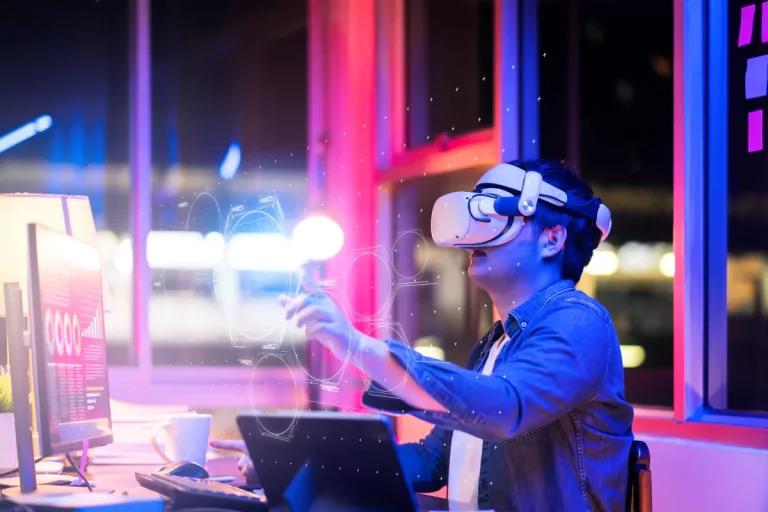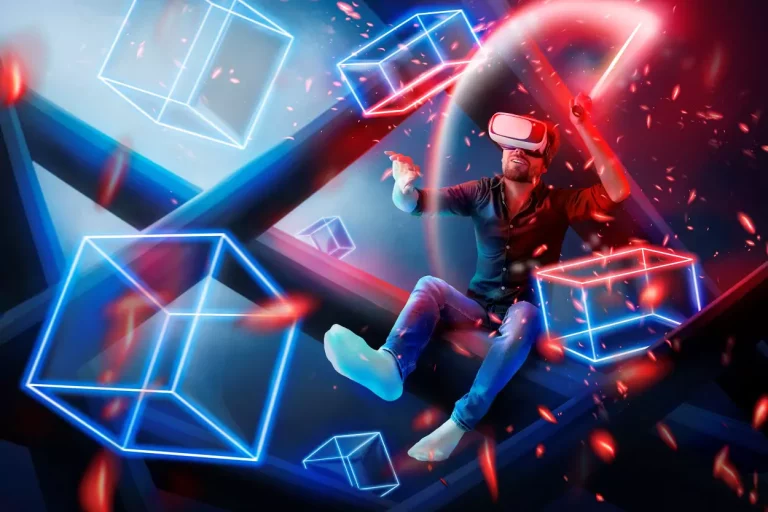Augmented Reality (AR)
Augmented reality (AR) is a technology that superimposes a computer-generated image on a user’s view of the real world, thus providing a composite view. AR can be used to overlay digital information on top of a physical object, such as a building or a product. It can also be used to create interactive experiences, such as games or educational applications.
There are two main types of AR: marker-based AR and markerless AR. Marker-based AR uses physical markers to track the user’s position in the real world. These markers can be anything from QR codes to physical objects. Markerless AR does not require any markers, and it can track the user’s position using sensors in the device.
Virtual Reality (VR)
Virtual reality (VR) is a technology that creates a simulated environment that can be experienced by a user. VR headsets are used to block out the real world and immerse the user in the virtual environment. VR can be used for gaming, entertainment, training, and education.
There are two main types of VR: tethered VR and standalone VR. Tethered VR headsets are connected to a computer or gaming console, while standalone VR headsets are self-contained and do not require any external devices.
Benefits of AR/VR
AR and VR offer a number of benefits over traditional technologies. They can:
- Provide a more immersive experience. AR and VR can transport you to another world, or they can overlay information on the real world in a way that is more engaging than traditional 2D interfaces.
- Be more interactive. AR and VR allow you to interact with the virtual world in a more natural way. For example, you can use your hands to manipulate objects in VR, or you can use your voice to control AR experiences.
- Be more informative. AR and VR can be used to provide information in a more engaging and informative way. For example, you could use AR to see how a machine works, or you could use VR to take a virtual tour of a historical site.
Applications of AR/VR
AR and VR are still in their early stages, but they have the potential to revolutionize the way we interact with the world around us. They are already being used in a variety of industries, and they are only going to become more popular in the years to come.
Some of the potential applications of AR/VR include:
- Gaming. AR and VR are already being used in gaming, and they have the potential to create even more immersive and engaging gaming experiences.
- Education. AR and VR can be used to create interactive learning experiences that are more engaging and informative than traditional textbooks.
- Healthcare. AR and VR can be used to train medical professionals, provide remote diagnosis and treatment, and even create immersive environments for patients to explore.
- Retail. AR and VR can be used to create interactive shopping experiences that allow customers to try on clothes, see how furniture will look in their home, and even take virtual tours of stores.
The Future of AR/VR
The future of AR/VR is bright. These technologies have the potential to revolutionize the way we interact with the world around us, and they are only going to become more popular in the years to come. Some of the potential future applications of AR/VR include:
- Telepresence. AR and VR can be used to create telepresence experiences, where people can interact with each other in a virtual environment. This could be used for business meetings, medical consultations, or even social gatherings.
- Remote learning. AR and VR can be used to create remote learning experiences, where students can learn from anywhere in the world. This could be used for distance learning or for providing students with access to specialized equipment or resources.
- Product design. AR and VR can be used to design products in a more immersive and interactive way. This could help designers to better understand how products will be used in the real world, and it could also help to reduce the time and cost of product development.
Conclusion
AR and VR are two of the most exciting technologies of our time. They have the potential to revolutionize the way we interact with the world around us, and they are only going to become more popular in the years to come. If you are interested in learning more about AR/VR, there are a number of resources available online. You can also find AR/VR headsets and apps at most major retailers.
Image by pikisuperstar on Freepik




